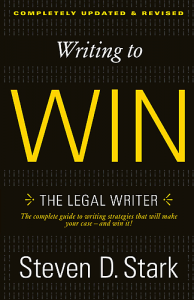Roughly a month ago I received a review copy of Steven Stark’s Writing To Win. It’s taken this long for me to get the review up because A) I’ve been busy and B) I always fully read any book I receive and Writing To Win is long and dense – albiet in the all the best ways possible. Writing To Win now sits next to Ross Guberman’s Point Made as one of my favorite books on legal writing.
In my review of Point Made I stated:
Point Made is not an introductory level book. If you’re not familiar with basic legal writing, you might be better off starting somewhere else. But it might be the best technique oriented legal book I’ve ever read . . . Point Made is a tactical book. Point Made provides granular-level advice that can immediately be implemented in your writing.
Writing To Win is the introductory book I would hand anyone looking to learn about legal writing. If I were to design a legal writing course, it would be the course textbook.
Writing To Win’s strength is in its organization and clarity of purpose. Both of which are what Stark emphasizes again and again as fundamental tenant of strong legal writing. The book is broken into four section:
- The Fundamentals of Legal Writing
- The Fundamentals of Argument for All Lawyers
- Writing in Litigation
- Writing in Legal Practice
The first section, The Fundamentals of Legal Writing, begins with a focus on organization. It then moves into the actual construction of text. Like every other good book on legal writing in emphasizes core points:
- Avoid legal jargon
- Keep it short
- Keep it simple
- Write for the reader, not for yourself
But Stark lays it out in a very effective way. Each topic is broken down, examined, then placed into context of the the larger purposes of legal writing. Each topic also flows directly into the next one while building on top of the previous material. It’s masterfully done – the text is a perfect example of the type of writing Stark is discussing.
The second section, The Fundamentals of Argument for All Lawyers, takes a very different approach to crafting legal arguments than I imagine is taught in most law schools. For example this section:
So any time you compose an argument . . . my advice would be to do enough research first to get a general sens of the law. No matter how complex the matter, this research should never take more than an hour or so. Then put all you research aside ask yourself, if I had to explain to a judge, or another lawyer, or a client why we should win without resorting to any precedent or law, what would I say? In laymen’s terms, why are we right? Then write those reasons down. . .
Outline the argument, research it later.
Which I have found to be an excellent tool in my own writing. It’s just a shame that I had to come to it on my own and was not taught it in law school. I was also pleased to see that Stark gave heavy emphasis to the advertising industry. Like I stated in my post about the writing blogs I follow, I think lawyers could gain a lot my studying the techniques the advertising industry uses to persuade consumers. It’s nice to see it echoed in Writing To Win.
Also, Stark emphasizes the use of narrative in argument. A well constructed narrative is the difference between a slog of a brief and one that pulls the reader along. Stark quotes Chief Justice John Roberts in this section, which makes the point most succinctly:
Every lawsuit is a story, I don’t care if it’s about a dry contract interpretation; you’ve got two people who want to accomplish something, and they’re coming together – that’s a story. And you’ve got to tell a good story.
Sorry lawyers, you’ve got to be good authors too. But most of you probably secretly want to do that anyway.
The last two sections, Writing in Litigation and Writing in Legal Practice, provide detailed strategies for tackling a number of styles of legal writing. From affidavits to appeals, from memos to emails, Stark provides concrete methods for making smooth, organized, flowing language that should make the text easier to parse for readers. The sections are littered with tips like study a cookbook or board game to improve your technical writing (taking a complex set of rules and systems and explaining them in a way that anyone can understand). It’s too much to go into here, but it Stark does an excellent job covering the most common writing scenarios lawyers deal with day to day.
__________________
Earlier I stated that Writing To Win “is the introductory book I would hand anyone looking to learn about legal writing.” This not because the book is simple or a beginner level book – it’s because it is one of the clearest and most well organized books on legal writing I’ve had the pleasure to read. Any law student or new lawyer looking to brush up on their writing skills would do well to pick up this book. Highly recommended.
Click Here To BuyWorth noting, the Appendix of the book contains 8 General Rules for Professionalism in Legal Writing. The number one rule?
Never lie under any circumstance.
Sometimes I think lawyers forget that.















